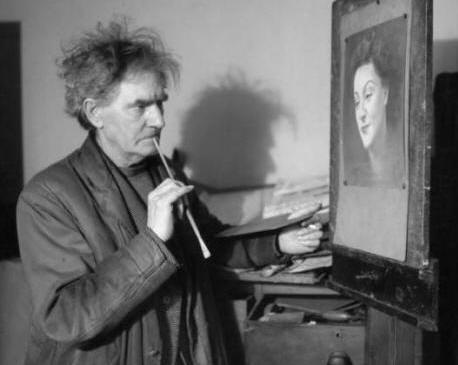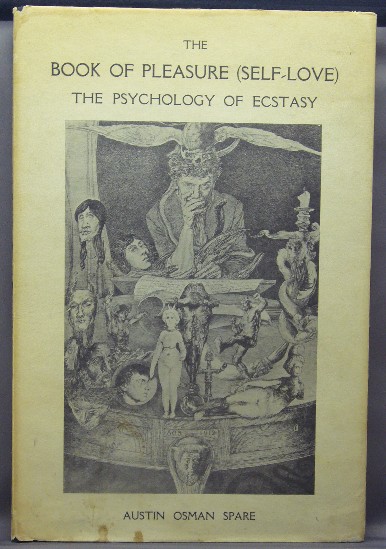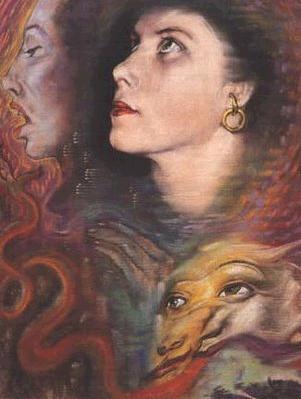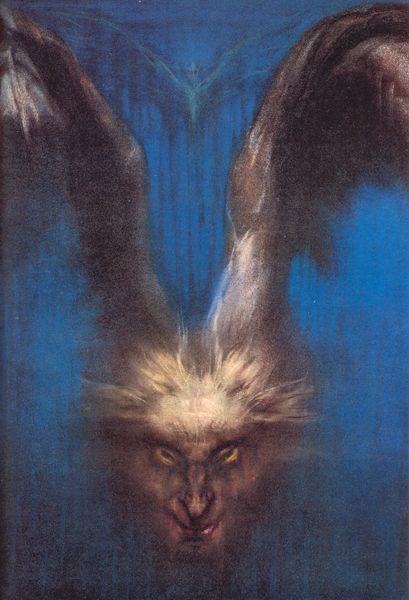|
|
| home | features | exhibitions | interviews | profiles | webprojects | gazetteer | links | archive | forum |
|
Austin Osman Spare: English Satyr, Magus-Artist and Astral Visionary Adam Daly
The Trajectory of a Witch-Mother’s Progeny Spare was born in 1886 - though he himself seemed uncertain of this, conjecturing once that he may have been born in either 1888 or 1889 - his family background a humble and impoverished one, affording few outlets for the precociously talented misfit that had popped into its midst. At the age of seven he had what was the most significant early formative experience of his life: he met an old woman by the name of Mrs. Patterson, who claimed to be a witch and a sorceress. Recognizing his unusual gifts took him under her tutelary wing, inducting him into various magical arts. She must also have been a surrogate mother to some extent, as he felt smothered by and even estranged from his own mother and four sisters - with his father being a somewhat absent figure, working nightshifts whilst leaving his wife to bring up their children almost single-handedly. Spare’s interest and later involvement in the Occult was sparked and guided by his ‘witch-mother’, who he famously painted on one occasion, the portrait being reputed to change before the eyes of whoever gazed upon it, as if she had imputed her self-rejuvenating powers to the very image itself, congealing her spirit in a Talismanic likeness.
He met Aleister Crowley during the Edwardian twilight-throes of the Decadence, Crowley recognizing in the younger Spare a potential equal in the realm of occult power, a successor-Hierophant of hubris, and invited him to join The Order of the Silver Star, an occult society, which he did in 1910. But their friendship didn’t last long, as Spare had quite different ideas from Crowley and didn’t altogether approve of his conspicuous glorying in Evil for Evil’s sake, not because Spare was incapable of Evil, as we shall see, but because he had perhaps a graver appreciation of its true import. There’s a story about him, which has many versions though it probably isn’t totally apocryphal, that two men visited him once demanding that he perform a very dangerous magical operation, known as Raising an Elemental. This is an unearthly apparition which can consume the spirit of its beholder. At first he refused, but they persisted so much that he finally relented, and after a brief period of fierce concentration, a phantasmagoric green mist appeared inside the room, from which a ghastly Form emerged. The upshot of this experience was that one of the men committed suicide not long after, and the other ended up in an Asylum. It was as if Spare was saying: ‘Let the hectoring fools have their way, and on their own heads be it.’ This is a rather sophisticated take on ‘Do what thou wilt shall be the whole of the Law’, Crowley’s Credo, which smacks of mere adolescent anarchy by comparison.
By 1924 Spare had reached the zenith of his popularity - a paradoxical notion, considering his superlative strangeness - but was also finally resolved to abandon altogether the despicably superficial, two-faced, celebrity-cabals he’d been drawn into when scarcely out of his teens. And the fruit of this resolution was his great work, The Anathema of Zos - Zos being the magical name his witch-mother had given to him, around which his Cultus/Mythos was taking form, like Lovecraft’s Chthulhu. This was perhaps his most personal statement, the most powerful expression of his anger and Antinomian outrage. It also marked a turning-point in his life, as he then refused all prospect of fame and wealth that establishment success would bring him and opted instead for a life of poverty, squalor and oblivion, ‘a swine among swine’ as he put it, in a seedy pied-a-terre in Southwark, eventually becoming a recluse. He continued working however, day in day out, for the next thirty odd years, rarely exhibiting or publishing anything and scraping a living doing portraits of local people in pubs - amongst whom he felt oddly at home, in spite of being a million light years away from them in his mind. He accumulated a substantial body of work during this period, for which of course he mainly achieved only posthumous recognition.
A Digest of the Secretions of a Grey Eminence Spare developed a number of techniques for accessing the Astral Light, which he felt was not only out there in the ether as it were, but also buried deep in the sub-reptilian strata of our own make-up. ‘Atavistic resurgence’ was one of the terms he used in this context, which involved effectively switching off the rational, conscious mode of our thinking and following the instinctual impulses in our unconscious minds, which put us in touch with the Beast or Satyr within. He didn’t advocate this in order to induce violent behaviour in people towards others, but to release the inhibitory mechanisms which prevent them from merging with their own natures. ‘Blacking out’, the ‘death-posture’ and ‘sigillization’ were all means of achieving this end. Although he thought each individual should develop his own system, which should work best for him.
Unlike Lovecraft, who did not believe at all in the Supernatural - fully in spite of his uncanny ability to evoke it in many of his stories - and declared himself a thorough-going Materialist, Spare was never content with Materialism, believing in something more akin to the Gnostic doctrine of ‘the Divine spark’, which kick-started Creation and cannot therefore have partaken of its material nature. The Idealist Philosophers developed much the same notion in even more elaborate terms, especially Schelling, who studied Magic, and imputed the power of symbolic representation and expression to the Transcendental Ego, which was for him the philosophical embodiment of The Great Magus of Mankind - in both its individual and collective capacities. For a long time such schools of thought were anathema to academic philosophers. But in more recent times, since the Positivistic obsession with Linguistic Analysis has run its course, I’ve detected a resurgence of scholarly interest in metaphysical and even mystical currents of thought. Wittgenstein after all, was always a mystic as well as a logician, and may have seen in Spare’s Sigils corollaries to his own notations.
Austin Osman Spare featured in the Dark Monarch at Tate St Ives, Winter 2009. Abridged from a longer essay 18/2/10 |
|
|

 Spare
completed his formal education early and served an apprenticeship while he began
his studies in Art. Eventually he won a scholarship to the Royal College of Art,
which initially promised to open doors onto the sunlit uplands of a glittering
career. His talents were noticed by no less a figure in the Art-Establishment
than John Singer Sargent, the great doyen of elegant portraiture, who thought he
could become the leading artist of his time, claiming his skills in
draughtsmanship were unparalleled by any of his contemporaries. He started
exhibiting his work while still a student, luxuriating in his own forbidding
mystique, and quickly came to widespread public attention. In 1905, he published
his first book, Earth Inferno, which signalled a lifelong fascination
with grotesque figures in ‘death-postures’ and ‘astral forms’, about which more
later. After finishing his studies, he rather curiously became a leading player
in the then fashionable London art-scene, no doubt on account of his looks and
the spell-binding effect he had on people, not least women. The man who was
later to produce The Book of Satyrs, was quite a satyr himself - at any
rate in terms of his philandering libertine conduct, if not alarming hirsute
transformation! And yet his heart and soul were not truly in this essentially
shallow, ephemeral, self-aggrandizing, Demi-Monde.
Spare
completed his formal education early and served an apprenticeship while he began
his studies in Art. Eventually he won a scholarship to the Royal College of Art,
which initially promised to open doors onto the sunlit uplands of a glittering
career. His talents were noticed by no less a figure in the Art-Establishment
than John Singer Sargent, the great doyen of elegant portraiture, who thought he
could become the leading artist of his time, claiming his skills in
draughtsmanship were unparalleled by any of his contemporaries. He started
exhibiting his work while still a student, luxuriating in his own forbidding
mystique, and quickly came to widespread public attention. In 1905, he published
his first book, Earth Inferno, which signalled a lifelong fascination
with grotesque figures in ‘death-postures’ and ‘astral forms’, about which more
later. After finishing his studies, he rather curiously became a leading player
in the then fashionable London art-scene, no doubt on account of his looks and
the spell-binding effect he had on people, not least women. The man who was
later to produce The Book of Satyrs, was quite a satyr himself - at any
rate in terms of his philandering libertine conduct, if not alarming hirsute
transformation! And yet his heart and soul were not truly in this essentially
shallow, ephemeral, self-aggrandizing, Demi-Monde.  Spare’s own
ideas on magic and related subjects were taking shape in what was to become his
most famous work, The Book of Pleasure. It contained many drawings,
philosophy, and a manual for the use of sigils, which I’ll touch on later. But a
dark shadow was looming on the horizon of the world, which eclipsed the sun of
his own paradisiacal vision: the First World War. He didn’t join the army until
1916, and was perhaps lucky not to be sent to the Somme. Instead, like Mervyn
Peake in the Second World War, he served as an official war artist, and was
posted to Egypt, where he developed a fascination for that country’s ancient
mysteries and rites, and generally managed to keep out of harm’s way. He
returned to London after the war, and in 1921 his book The Focus of Life
was published, in which for the first time he emphasized Chaos as the central
governing principle of all things, and of the Self. This later gave rise to the
development of so-called Chaos Magic, although it might also be claimed that he
had an original insight into what became the mathematical science of Chaos
Theory, and through his interest in the complex intersections and layering of
plane surfaces in Representational Art, he might be said to have anticipated
Mandelbrot’s Fractal Geometry after a fashion. There has even been a political
movement known as ‘Chaosism’, which bears some similarities to anarchism and
nihilism, though it’s uncertain whether Spare’s work has ever directly inspired
revolutionaries as such.
Spare’s own
ideas on magic and related subjects were taking shape in what was to become his
most famous work, The Book of Pleasure. It contained many drawings,
philosophy, and a manual for the use of sigils, which I’ll touch on later. But a
dark shadow was looming on the horizon of the world, which eclipsed the sun of
his own paradisiacal vision: the First World War. He didn’t join the army until
1916, and was perhaps lucky not to be sent to the Somme. Instead, like Mervyn
Peake in the Second World War, he served as an official war artist, and was
posted to Egypt, where he developed a fascination for that country’s ancient
mysteries and rites, and generally managed to keep out of harm’s way. He
returned to London after the war, and in 1921 his book The Focus of Life
was published, in which for the first time he emphasized Chaos as the central
governing principle of all things, and of the Self. This later gave rise to the
development of so-called Chaos Magic, although it might also be claimed that he
had an original insight into what became the mathematical science of Chaos
Theory, and through his interest in the complex intersections and layering of
plane surfaces in Representational Art, he might be said to have anticipated
Mandelbrot’s Fractal Geometry after a fashion. There has even been a political
movement known as ‘Chaosism’, which bears some similarities to anarchism and
nihilism, though it’s uncertain whether Spare’s work has ever directly inspired
revolutionaries as such. 
 Blacking
out involved hyper-ventilating till one broke out in sweat, puffed violently and
then reached the point of fainting. In this state - similar to the Shamanic
trance - one can perceive astral phenomena more vividly, and store the
impressions in one’s mind for future retrieval. Conversely, one can still
oneself by cultivating the 'death-posture', simulating the death’s cast of one’s
own anatomy, and thereby sinking into a deep meditative state, growing
ultra-receptive to the energies and influences which course through one. This is
like surrendering oneself to greater powers, which then reanimate one as a
conduit for astral communications, facilitating various activities like
automatic writing or dictated messages. Concentrating or focusing on Sigils
in the mind’s eye - an act of symbolic introspection - enabled one to target and
release one’s desires, which are fulfilled in the sympathetic or antipathetic
response of their intended objects. Depicting the Sigils and staring at them can
obviously help to impress them on one’s mind, so one interiorizes them. This is
the easy, conscious part of the operation. The hard part is allowing the
unconscious to act on the information and instructions received, and then to let
go of one’s conscious control, so as to effect a successful ‘working’. But Spare
seemed to have very little difficulty in doing this, as he felt himself to be
almost constantly in touch with his Familiars and Elementals. So even the
performance of rituals was not always necessary, as he could summon or invoke an
astral entity almost at will very simply and directly, at least some of the
time.
Blacking
out involved hyper-ventilating till one broke out in sweat, puffed violently and
then reached the point of fainting. In this state - similar to the Shamanic
trance - one can perceive astral phenomena more vividly, and store the
impressions in one’s mind for future retrieval. Conversely, one can still
oneself by cultivating the 'death-posture', simulating the death’s cast of one’s
own anatomy, and thereby sinking into a deep meditative state, growing
ultra-receptive to the energies and influences which course through one. This is
like surrendering oneself to greater powers, which then reanimate one as a
conduit for astral communications, facilitating various activities like
automatic writing or dictated messages. Concentrating or focusing on Sigils
in the mind’s eye - an act of symbolic introspection - enabled one to target and
release one’s desires, which are fulfilled in the sympathetic or antipathetic
response of their intended objects. Depicting the Sigils and staring at them can
obviously help to impress them on one’s mind, so one interiorizes them. This is
the easy, conscious part of the operation. The hard part is allowing the
unconscious to act on the information and instructions received, and then to let
go of one’s conscious control, so as to effect a successful ‘working’. But Spare
seemed to have very little difficulty in doing this, as he felt himself to be
almost constantly in touch with his Familiars and Elementals. So even the
performance of rituals was not always necessary, as he could summon or invoke an
astral entity almost at will very simply and directly, at least some of the
time.